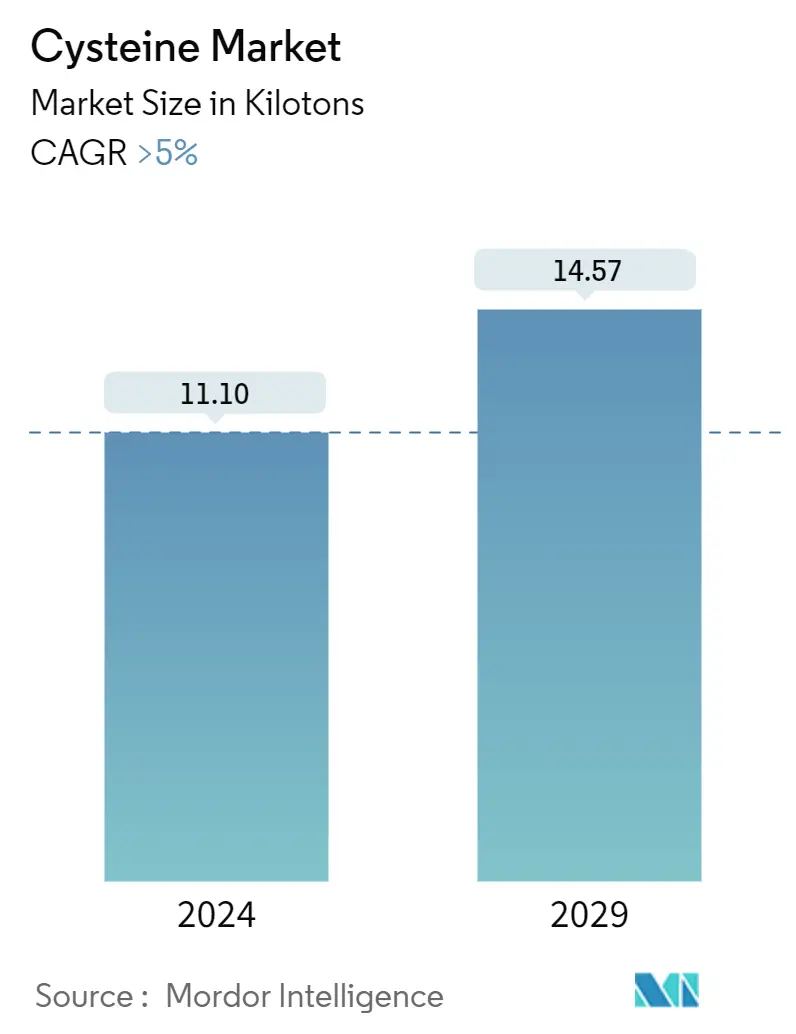Market Size of Cysteine Industry

| Study Period | 2019 - 2029 |
| Base Year For Estimation | 2023 |
| CAGR (2024 - 2029) | 5.00 % |
| Fastest Growing Market | Asia Pacific |
| Largest Market | Asia Pacific |
| Market Concentration | High |
Major Players
*Disclaimer: Major Players sorted in no particular order |
Cysteine Market Analysis
The Cysteine Market size is estimated at 11.10 kilotons in 2024, and is expected to reach 14.57 kilotons by 2029, growing at a CAGR of greater than 5% during the forecast period (2024-2029).
The cysteine market was hampered due to COVID-19. Lockdowns, restrictions, and economic uncertainties led to shifts in consumer behavior and affected various industries, influencing the demand for cysteine-derived products. However, the conditions started recovering in 2021, which is expected to restore the market's growth during the forecast period.
- The increasing demand from the bakery and pharmaceutical industry is likely to stimulate the cysteine market globally, during the forecast period.
- However, increasing concerns related to animal-sourced cysteine, and the harmful effects of cysteine on the human body are expected to hamper the cysteine market.
- The development of palladium reagents for cysteine S-arylation and the development of cysteine derivatives for the treatment of various conditions is expected to provide an opportunity for market growth in the upcoming period.
- Asia-Pacific, with the largest consumption from India, is expected to dominate the cysteine market.
Cysteine Industry Segmentation
Cysteine is a non-essential amino acid that is important for the production of protein and for other metabolic functions. It is found in beta keratin. It is the primary protein present in nails, skin, and hair. Cysteine is also important for making collagen which affects the elasticity and texture of skin. Also, Cysteine has antioxidant properties.
Cysteine market is segmented based on the production process, application, end-user industry, and geography. Based on the production process, the market is segmented into natural, and synthetic. Based on application, the market is segmented into conditioner, flavor enhancer, reducing agent, production of human insulin, and other applications (anti-aging agent). Based on the end-user industry, the market is segmented into food, pharmaceutical, animal feed, and other end-user industries (marine). The report also covers the market size and forecasts for the cysteine market for 15 major countries. For each segment, the market sizing and forecasts are provided in terms of value (USD).
| Production Process | |
| Natural | |
| Synthetic |
| Application | |
| Conditioner | |
| Flavor Enhancer | |
| Reducing Agent | |
| Production of Human Insulin | |
| Other Applications (Anti-aging Agent) |
| End-user Industry | |
| Food | |
| Pharmaceutical | |
| Animal Feed | |
| Other End-user Industries (Marine) |
| Geography | |||||||||
| |||||||||
| |||||||||
| |||||||||
| |||||||||
|
Cysteine Market Size Summary
The cysteine market is poised for significant growth over the forecast period, driven by increasing demand from the bakery and pharmaceutical industries. The market experienced disruptions due to the COVID-19 pandemic, which altered consumer behavior and impacted demand for cysteine-derived products. However, recovery began in 2021, setting the stage for renewed growth. Cysteine's role as a dough conditioner in the bakery sector enhances the elasticity and texture of dough, contributing to softer baked goods. This application, along with the rising trends in flavor fusion, particularly in regions like India, is expected to bolster demand. Despite concerns regarding animal-sourced cysteine and its potential health effects, advancements in cysteine derivatives and palladium reagents present new opportunities for market expansion.
The Asia-Pacific region, led by China and India, is anticipated to dominate the global cysteine market. China, a major producer, utilizes traditional methods for cysteine production, while its robust food service industry and animal feed production drive local demand. The Indian food processing sector's growth further supports the increasing need for cysteine. The market is characterized by consolidation, with key players such as CJ CheilJedang Corp., Wacker Chemie AG, Merck KGaA, Ajinomoto Co. Ltd, and Nippon Rika Co. Ltd holding significant market shares. These companies are actively involved in developments that shape the market landscape, ensuring a competitive environment as demand continues to rise.
Cysteine Market Size - Table of Contents
-
1. MARKET DYNAMICS
-
1.1 Drivers
-
1.1.1 Increasing Demand from the Bakery Industry
-
1.1.2 Rising Demand from Pharmaceutical Industry
-
-
1.2 Restraints
-
1.2.1 Increasing Concerns Related to Animal-sourced Cysteine
-
1.2.2 Harmful Effects of Cysteine on Human Body
-
-
1.3 Industry Value Chain Analysis
-
1.4 Porter's Five Forces Analysis
-
1.4.1 Bargaining Power of Suppliers
-
1.4.2 Bargaining Power of Consumers
-
1.4.3 Threat of New Entrants
-
1.4.4 Threat of Substitute Products and Services
-
1.4.5 Degree of Competition
-
-
1.5 Regulatory Policy Analysis
-
1.6 Patent Analysis
-
-
2. MARKET SEGMENTATION (Market Size in Volume)
-
2.1 Production Process
-
2.1.1 Natural
-
2.1.2 Synthetic
-
-
2.2 Application
-
2.2.1 Conditioner
-
2.2.2 Flavor Enhancer
-
2.2.3 Reducing Agent
-
2.2.4 Production of Human Insulin
-
2.2.5 Other Applications (Anti-aging Agent)
-
-
2.3 End-user Industry
-
2.3.1 Food
-
2.3.2 Pharmaceutical
-
2.3.3 Animal Feed
-
2.3.4 Other End-user Industries (Marine)
-
-
2.4 Geography
-
2.4.1 Asia-Pacific
-
2.4.1.1 China
-
2.4.1.2 India
-
2.4.1.3 Japan
-
2.4.1.4 South Korea
-
2.4.1.5 ASEAN Countries
-
2.4.1.6 Rest of Asia-Pacific
-
-
2.4.2 North America
-
2.4.2.1 United States
-
2.4.2.2 Canada
-
2.4.2.3 Mexico
-
-
2.4.3 Europe
-
2.4.3.1 Germany
-
2.4.3.2 United Kingdom
-
2.4.3.3 France
-
2.4.3.4 Italy
-
2.4.3.5 Russia
-
2.4.3.6 Nordic Countries
-
2.4.3.7 Rest of Europe
-
-
2.4.4 South America
-
2.4.4.1 Brazil
-
2.4.4.2 Argentina
-
2.4.4.3 Rest of South America
-
-
2.4.5 Middle-East and Africa
-
2.4.5.1 GCC Countries
-
2.4.5.2 South Africa
-
2.4.5.3 Rest of Middle-East and Africa
-
-
-
Cysteine Market Size FAQs
How big is the Cysteine Market?
The Cysteine Market size is expected to reach 11.10 kilotons in 2024 and grow at a CAGR of greater than 5% to reach 14.57 kilotons by 2029.
What is the current Cysteine Market size?
In 2024, the Cysteine Market size is expected to reach 11.10 kilotons.

